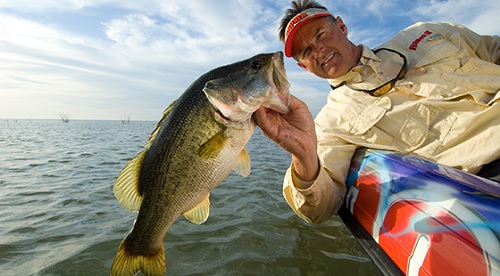 When big fish are following tiny forage, you gotta go small for big success. To match the hatch, tie on a Rapala® Ultra Light Pop. “When you hear people talking ‘match the hatch,’ they’re often talking more about color,” says Bernie Schultz, a seven-time Bassmaster Classic qualifier. “But matching the size of the forage that fish are eating is equally important in getting bites.” In certain times of year, even the biggest fish will key more on fry and young-of-year baitfish than larger, mature forage.
When big fish are following tiny forage, you gotta go small for big success. To match the hatch, tie on a Rapala® Ultra Light Pop. “When you hear people talking ‘match the hatch,’ they’re often talking more about color,” says Bernie Schultz, a seven-time Bassmaster Classic qualifier. “But matching the size of the forage that fish are eating is equally important in getting bites.” In certain times of year, even the biggest fish will key more on fry and young-of-year baitfish than larger, mature forage.

Designed to offer big action in a small package, the Ultra Light Pop is a new tool to target those fish effectively. Measuring a compact 1 1/2 inches, it weighs 1/8 oz. — just enough weight to ensure a long, smooth cast to the strike zone.
Featuring a deep, cupped lip with a thin, flat chin, the Ultra Light Pop will elicit epic reaction bites from big bass and large panfish. Cast it as far as you can — especially in clear water — then wait for the ripples to clear. Then, using your wrists, pop it two or three times and let it rest again – then repeat. It will produce a popping action that draws in bass from afar.
“The key is the sound — that blooping, popping, spitting sound,” Schultz explains. “It sounds like schooling or injured shad or other baitfish surfacing.” As predators, bass are programmed to react when they hear a disturbance on the surface like that. “It signals an opportunity for an easy meal,” Schultz explains. “And that can really trigger those bigger fish.”
For bass, the Ultra Light Pop will really shine in the late post-spawn period when pods of fry are prevalent, during summer mayfly hatches, and in the fall when young-of-year shad are moving to the backs of creeks. Target submerged wood, brush and rocks, docks, tops and edges of humps and drop-offs on the edges of flats. In most cases, cast the Ultra Light Pop past your target and then pop it back to the strike zone and pause it – sometimes for just a second, other times for as much as a minute.
“That pause, especially around a target – whether it’s a hole in the grass, or a reed clump sticking out of the water, or a dock piling, or a cypress knee — is crucial to getting the bite,” Schultz says. “It draws attention to the lure and it provokes the fish to the point where he’s inclined to strike.”
Vary your retrieve cadence until you get a strike. Then duplicate what worked until it’s no longer effective. Then begin experimenting again.
Effective in both clear and lightly stained water with a light chop, the Ultra Light Pop is outfitted with an internal rattle, 3D holographic eyes and two No. 12 VMC black-nickel round-bend treble hooks. It’s available in eight color patterns: Clown, Lime Frog, Chrome, Gold Chrome, Firetiger, Yellow Perch, Frog and Silver Blue.
For the best results, throw an Ultra Light Pop with a medium-heavy spinning reel on as heavy a monofilament line as you can make a good, long cast with. “I can tell you from years of experience that you do not want light line when you’re throwing topwater plugs,” Schultz explains. With too light a line, your lure can over-run the line on the retrieve and foul its hooks.
Because fluorocarbon sinks, it’s not recommended for an Ultra Light Pop. It will pull down the bait’s nose, inhibiting its action. Incorrect action will make the wrong sound. “It’s essential that you use a floating line,” Schultz says. “I like Sufix Superior mono.”
